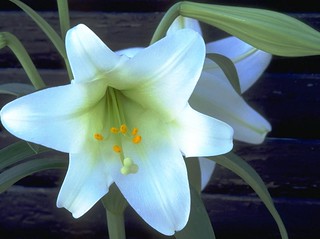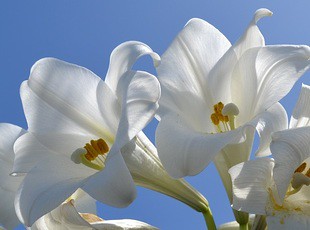The Amazing Journey of Your Easter Lily

Along a few miles of the Pacific Coast at the Oregon and California border lies a unique area where the ideal combination of climate, soil, water and man has developed a product of deep meaning, beauty and tradition - the Easter Lily.
The Harbor-Brookings bench of Southwest Curry County, Oregon and the Smith River area of Northwest Del Norte County, California, is known as the Easter Lily Capital of the World. Here, lily growers toil year-round in their fields to produce nearly all the bulbs from which the large trumpet-shaped flowers bloom.
Uniquely suited for the production of superior quality Easter Lily bulbs, the area offers a climate of year-round mild temperatures afforded by a protective bay, deep, rich, alluvial soils and abundant rainfall - the exact measure of ingredients needed to produce a consistently high quality bulb crop. The lily-perfect conditions combined with the ingenuity and dedication of the area's growers are why over 95% of the world's potted Easter Lilies originate from this narrow coastal strip.
The Easter Lily Capital is accessible only by a narrow and winding coastal highway banked by magnificent Redwood forests, overlooking the spectacularly scenic Pacific Ocean. It seems only fitting that the symbolic flower of Easter, which adds beauty, grace and fragrance to millions of homes, businesses and churches, has its roots in such a pristine and beautiful corner of the world.
The Easter Lily -- the Latin name is Lilium longiforum - is native to the southern islands of Japan. In the 1880's, it was widely cultivated in Bermuda and bulbs were shipped to this country. Around the turn of the century, the Japanese took over the annual growing exportation of Easter Lilies to the United States, and continued to dominate the U. S. export market until the start of World War II.
Current U. S. production began with a World War I soldier, Louis Houghton, who brought a suitcase full of hybrid lily bulbs to the South coast of Oregon in 1919. Houghton freely distributed bulbs to his horticultural friends and neighbors. When the Japanese attacked Pearl Harbor in 1941, the Japanese source of bulbs was abruptly cut off. As a result, the value of lily bulbs sky-rocketed and many who were growing the lilies as a hobby decided to go into business. The Easter Lily bulbs at that time were called "White Gold," and growers everywhere attempted to cash in on the crop. By 1945, there were about 1,200 growers producing bulbs up and down the Pacific coast, from Vancouver, Canada to Long Beach, California.
But, producing quality, consistent lily bulbs proved to be an exact and demanding science with specific climatic requirements. Over the years, the total number of Easter Lily bulb producers dwindled down to just ten farms in a small, isolated coastal region straddling the Oregon-California border. This region, called the Easter Lily Capital of the World, produces nearly all of the bulbs for the blooming potted Easter Lily market. Even after the Japanese started to ship bulbs in again after the war, they have never been able to come close to the quality of those healthy, U.S.-grown bulbs, and thus never regained any significant market share.

Precise growing conditions are necessary since the Easter Lily bulbs must be cultivated in the fields for three, and sometimes four years, before they are ready to be shipped to commercial greenhouse growers. Those years, however, are not a carefree time for the bulbs nor for the growers. The bulbs are never dormant and require constant care and attention to assure superior quality and cleanliness. Each bulb is handled up to 40 times before it is ready to be shipped.
A commercial- sized bulb often starts as a small, baby bulblet growing underground on the stem of its mother plant. When the mother plant is harvested, the bulblet is carefully removed and planted in another field. One year later, the bulblet, now called a yearling, is dug up again. The yearling is planted in a new field for another full year of cultivation and specialized care to allow it to grow into its full potential, maturity and status as a commercial bulb.
Bulb harvesting takes place each year in the fall, during late September and early October. At harvest time, the lily fields become a bustle of hectic activity as the growers orchestrate a 3-ring circus. Commercial-sized bulbs are dug, cleaned, graded, sorted, packed and cooled. Yearling bulbs are dug, treated and re-planted in newly-prepared fields for the following year's commercial crop. And, baby bulblets are stripped from the mother plants and tenderly placed in the ground to start them on the road to becoming commercial crops in 2 or 3 years.

The commercial bulbs are shipped to greenhouse growers throughout the United States and Canada who force the plants under controlled conditions to flower in time for Easter. This is a very tricky process since Easter falls on a different day each year, dependent upon celestial bodies. The first Sunday that follows the first full moon after the vernal equinox, Easter can be any day between March 22 and April 25. Crop scheduling and timing is critical - another reason why the bulbs have to be of such a consistent high quality with reliable vigor and performance. The flowers must bloom exactly when they're supposed to, with no margin for error.
From the fields to the greenhouse to your home, the Easter Lily remains the traditional, time-honored flower of Easter. Symbolic of a resurrection, Easter Lilies rise from earthy graves as scaly bulbs, and bloom into majestic flowers that embody the spirit of Easter.
